As an Amazon Associate, I earn from qualifying purchases with no additional costs for you.
There are numerous fake quartz crystals you can come across in the market, even if quartz is the most widespread mineral. Quartz naturally occurs in various colors, transparency, and mineral forms (separate crystals, druses, and microcrystalline aggregates).
This makes quartz a mineral to satisfy any taste. It also should minimize any possible fakes, but as we can see on the market, there are unexpectedly many quartz fakes.
To differentiate real and fake quartz, focus on 12 differences. Fake quartz’s color is too saturated (green, blue, pink). A surface coating that looks like iridescence on soap bubbles is a sign of a fake. Bubble inclusions, warm to-the-touch surface, and low hardness indicate fakes.
Quartz is so widespread that it can be found even in the backyard or the number of tons on the river banks. Unfortunately, even such a wide distribution doesn’t save us from fakes on the market. Further in the article, we will define the groups of quartz fakes.
We will focus on the surface coating of natural quartz, dying agates and chalcedonies, lab-grown synthetic quarts, and other non-mineral ridiculous materials like glass, plastic, and epoxy resins widely used to fake quartz.
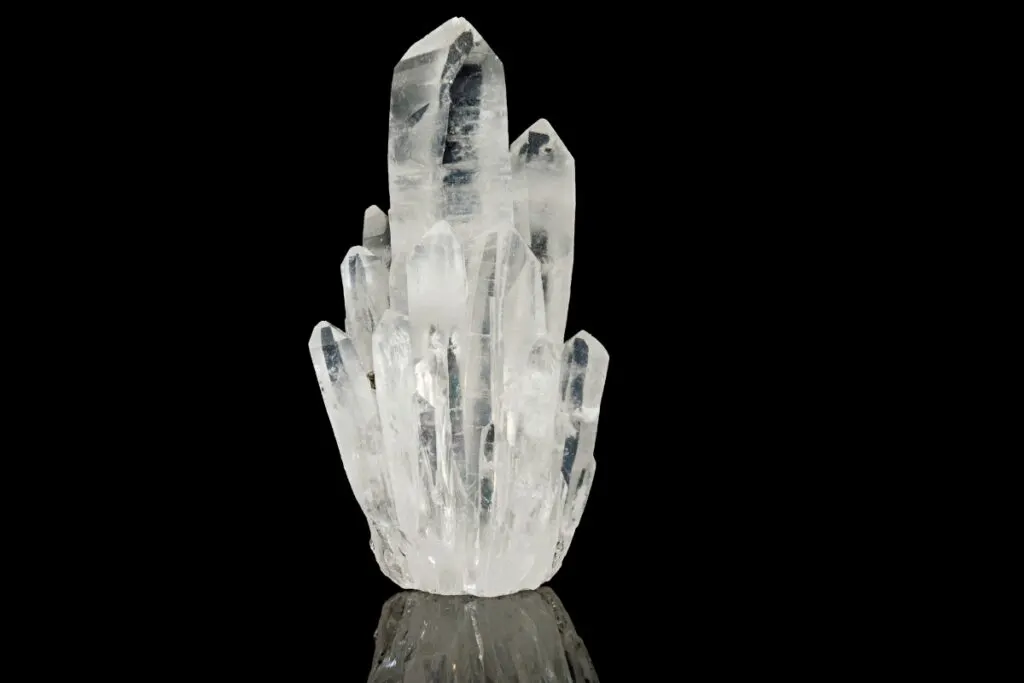
If you are interested in checking out the best books about rock and mineral identification you can find them by clicking here (Amazon link).
How to Tell if Quartz is Real
To tell if quartz is real, focus on quartz’s appearance, inclusions, and hardness. Real quartz occurs in calm natural colors (white, creamy, yellowish, brown, light pink, light green, and light blue, with purple for the amethyst variety). Real quartz always has inclusions. A knife cannot scratch real quartz.
Quartz is one of the most widespread minerals in the Earth’s crust. Quartz is undoubtedly extremely popular among mineral collectors, occurring in numerous colors and crystal forms.
Mineralogically speaking, chalcedony, agate, and jasper are also quartz varieties, where quartz grains are so tiny to be distinguished with an unaided eye.
Let’s discuss the features real quartz has.
- Quartz occurs in various colors because of impurities and trace elements, natural radiation, and defects in the crystal structure. Real quartz colors are never too bright and vividly saturated (except for some natural amethysts and citrines). Typical colors are commonly white, beige, grayish blue, light yellow, earthy orange, pale green, light pink, and brown.
- Quartz, like any other natural mineral, will always have some imperfections. These are other mineral inclusions (rutile, tourmaline, chlorite, chrysocolla, hematite, goethite, clinochlore, pyrite, dioptase, and many others), growth zones, fluid inclusions, and natural fractures. All these factors influence quartz transparency. Any real quartz will have some imperfections. If not, take a magnifying glass or microscope and take some time. We promise you will find something!
- Quartz hardness is the other very distinguishing feature. Quartz has a relative hardness of 7 on the 1 to 10 Mohs hardness scale. Quartz can be scratched only by topaz, corundum (ruby, sapphire), and diamond. So, you will not accomplish scratch quartz with common at-home tools like knives, scissors, nails, etc.
TIP: You are welcome to get to know all quartz varieties in our article:
Complete List of Quartz Varieties: Know Them All!
What Does Real Quartz Look Like
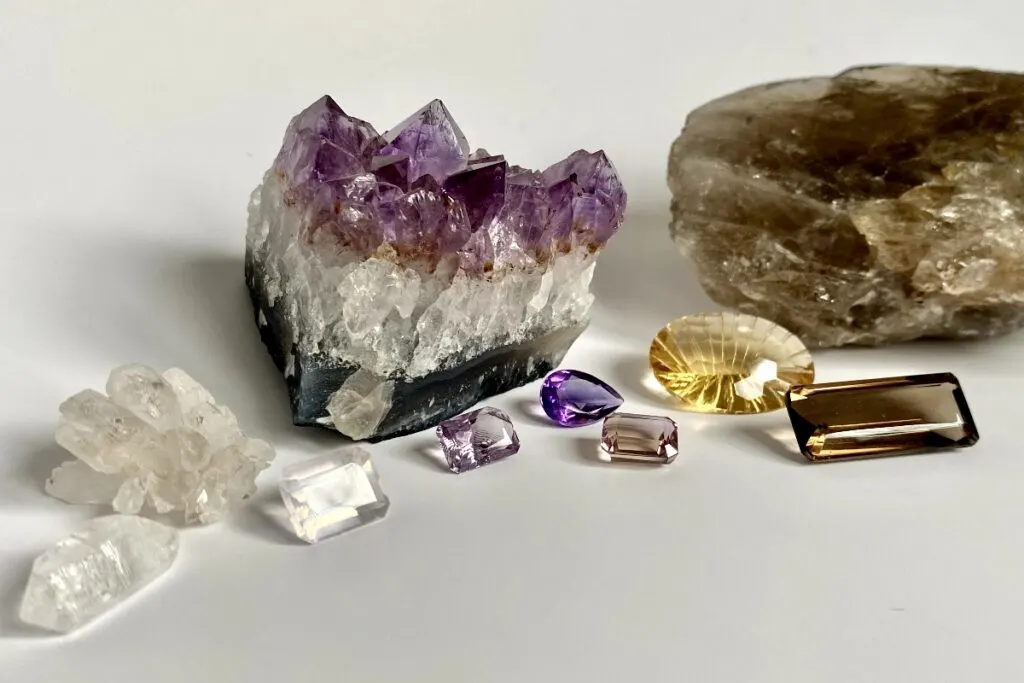
Real quartz looks different because of its numerous varieties. Real quartz can look like crystals with well-defined facets or be combined into druses.
Microcrystalline aggregates of quartz (agate, chalcedony) look banded and translucent. The colors are not vibrant (except for amethyst and citrine).
How to Test Quartz Stone at Home
To test quartz stone at home, make a hardness test with a knife to spot plastic fakes. Scratch the surface with metal to spot fake surface-coated quartz. Look for gas bubbles typical for glass fakes. Look for transparent zones to spot synthetics. Observe the interior for cracks and dye concentrated there.
To test quartz at home conduct the following three tests:
- Observation with a magnifying glass to study inclusions
- Scratch test to check for coating
- Hardness test to eliminate plastic, epoxy resin, and other polymer fakes.
These tests will not give you 100% certainty in your quartz origin. However, they will eliminate obvious plastic and coated fakes.
Check out our comprehend DIY Guide: Testing Mineral’s Hardness (Explained by Expert) for a step-by-step guide on testing hardness.
Do Quartz Glow Under Black-Light
Some quartz varieties glow under black light. However, a lot of quartz fakes also glow under UV. It’s hard to differentiate between real and fake quartz with only black light (UV) tests. A black-light (UV) test is considered an additional test but never the primary for spotting fakes.
BTW: Do you want to know more about rock and mineral identification? The books listed below are the best ones you can find on the internet (Amazon links):
- Smithsonian Handbooks: Rocks & Minerals
- Gemstone & Crystal Properties (Quick Study Home)
- Ultimate Explorer Field Guide: Rocks and Minerals (National Geographic Kids)
How to Tell Fake Quartz
There are unexpectedly many varieties of quartz fakes. We use the word ‘unexpectedly’ because nobody expects fakes from one of the most common minerals.
Unfortunately, there are dozens of varieties of quartz fakes. We will cover the most common of them, along with characteristic features of spotting quartz fakes.
To tell fake quartz mind unnaturally intense and vibrant colors (electric blue, fuchsia pink, emerald green). Fake quartz made of plastic and resins can be scratched by a knife. Fakes glow chalky white under UV light. Coated fake quartz looks iridescent. Synthetic fakes look internally flawless.
How to tell if Quartz is Lab Grown
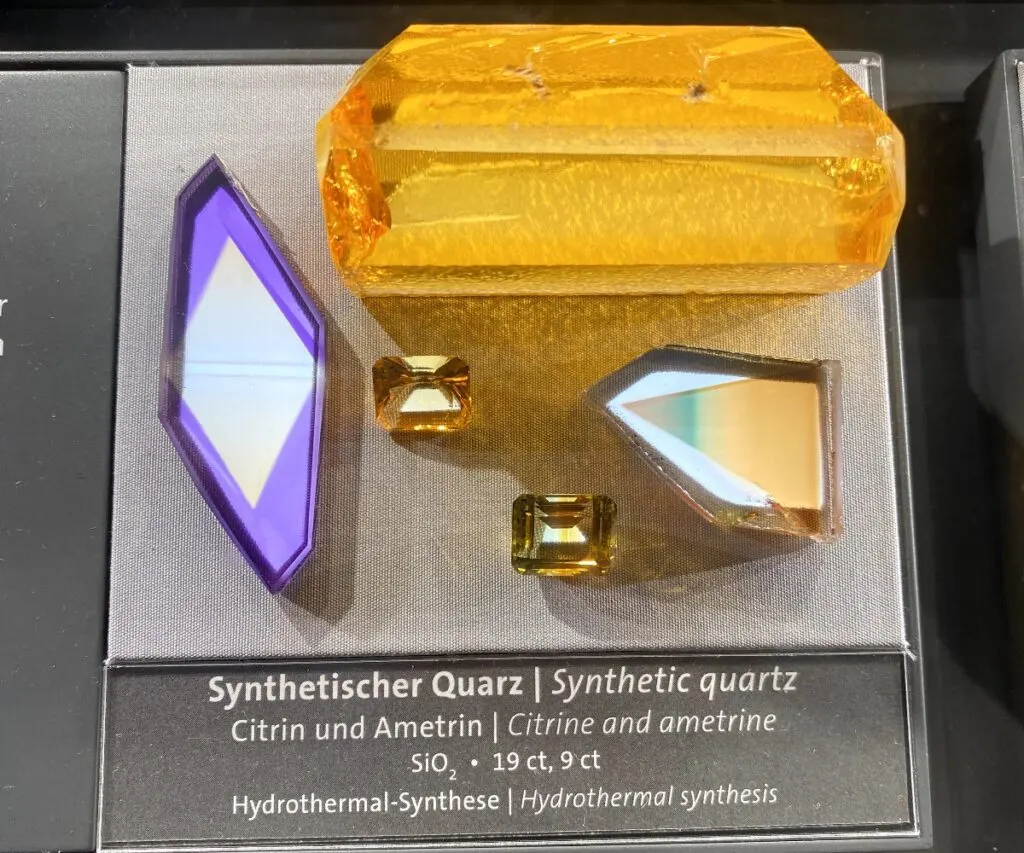
In the form of druses, lab-grown quartz occurs in bright green, yellow, blue, and pink colors. It has a second-generation overgrowth of sugar-like quartz crystals.
It’s almost impossible to spot lab-grown quartz in faceted gemstones. The general rule is that synthetics lack any inclusions and look flawless.
TIP: Quartz is the main component in the sand on many beaches across the world. Find out more about finding quartz on the beach in the article below:
Can You Find Quartz on the Beach? It Depends on How You Look
Can Quartz be Faked
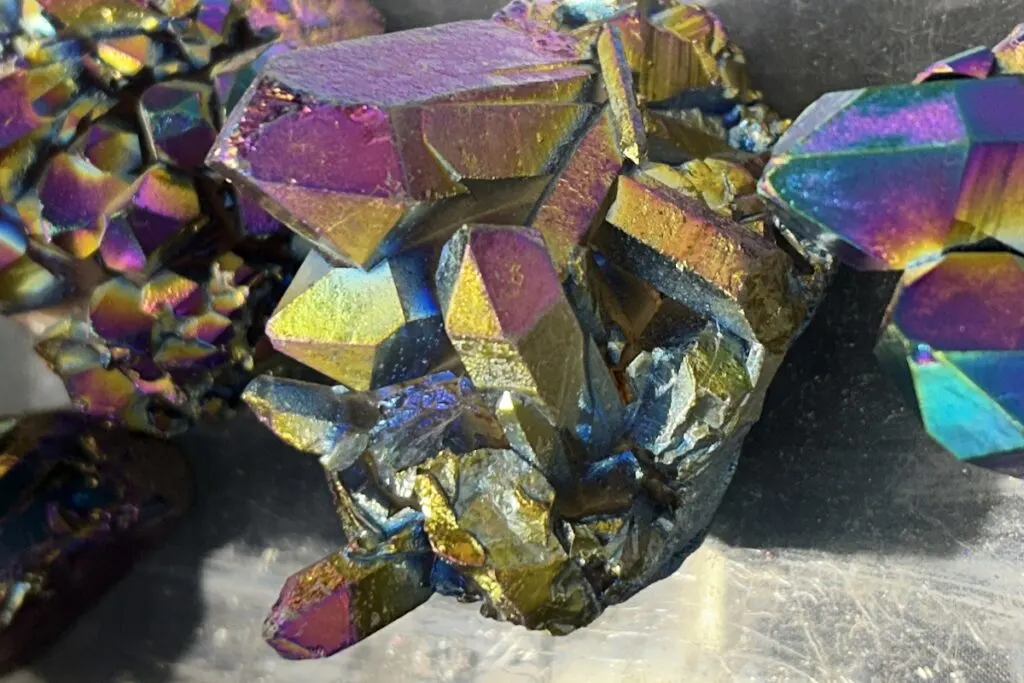
Quartz is severely faked. Some fakes are made of non-natural materials like plastic, epoxy resin, and glass. The other group is lab-grown quartz. It is chemically the same substance but created in a laboratory. The third group is natural quartz, enhanced by dyeing or coating processes.
Disclaimer! Please, read it. It is important.
Before describing every type of quartz fake, let’s pay attention to what can be called fake because some quartz fakes are natural but enhanced in some way. Others are chemically identical substances, however, grown in a lab.
In this article, we are considering any enhanced or lab-grown varieties as quartz fakes, as people buying quartz expect it to be genuinely natural and consider their characteristic features as vivid, saturated color, iridescence, or exceptional clarity of natural origin, which is definitely not.
Recommendation box: All tools and equipment you need for rockhounding and rock identification* (Amazon links):
1. Estwing Rock Hammer – Light, comfortable, and extremely durable hammer.
2. Estwing Geologist Pick – Classic and the most trusted paleo pick in the world.
3. Finder 12-inch Chisels – Heavy-duty chisels set with hand protection.
4. Mini Handle Shovel – This is a great tool for digging deep in the dirt.
5 Ironclad Utility Work Gloves – Breathable, but they also protect the areas requiring them most.
6. 3M Safety Glasses – Comfortable and efficient goggles for rockhounding.
7. Convoy 8+ UV Light – 365nm UV LED flashlight with a patented glass filter.
8. Wesley’s Jewelers Loupe – High magnification options (30X and 60X) with carrying case.
9. Mohs Hardness Kit – A specially designed kit for rockhounds
*All recommended products are personally tested and regularly used by experts from this website.
Treated quartz
This group of fakes is represented by low-quality real quarts being treated to enhance color or transparency characteristics.
- Aqua Aura Quartz
The most common quartz fake of this group is Aqua Aura quartz. It is real quartz coated with a thin metal layer (gold, titanium, indium, niobium, and copper) to create an iridescent surface on quartz crystals.
It has numerous synonyms, like Titanium Quartz, Mystic Quartz, Flame Aura Quartz, Pearl Aura, Blue Aura, Opal Aura Quartz, Angel Quartz, and Rainbow Aura Quartz. They slightly differ in background color but have a typical metallic luster and iridescence similar to soap bubbles.
There is a real Iris quartz, a variety of natural quartz with rainbow iridescence. However, Iris quartz has a significantly different appearance as its iridescence occurs under the surface and doesn’t cover the whole crystal.
- Dyed quartz
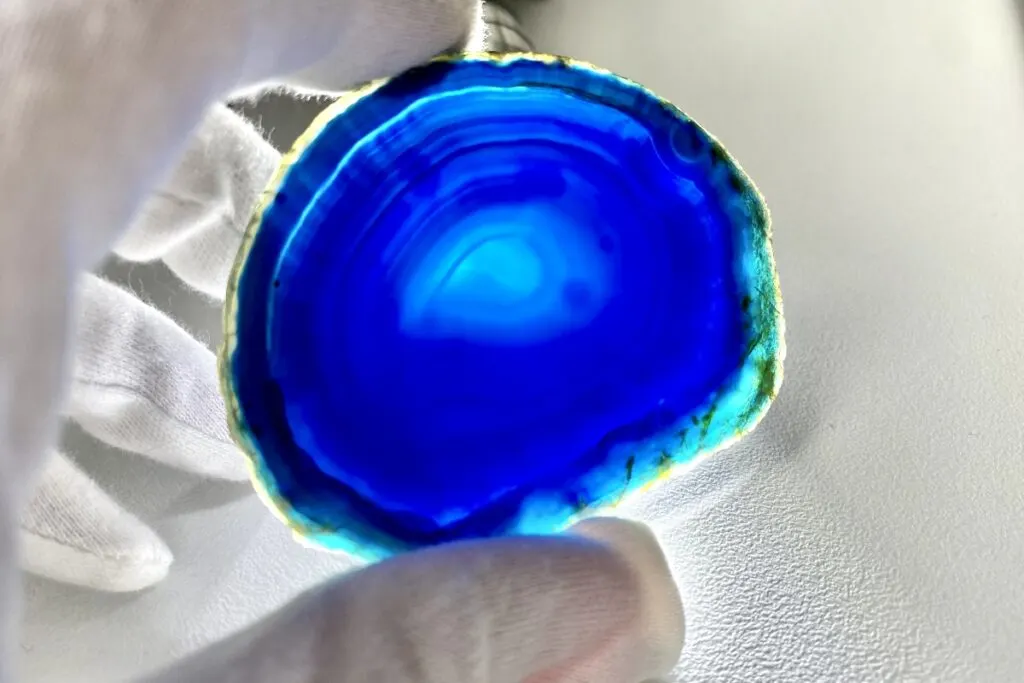
Manufacturers dye quartz to enhance the color and produce vivid blue, green, and pink varieties. Agate and chalcedony undergo dying more commonly because of their microcrystalline structure. The dye can easily penetrate between grains producing an evenly distributed final color.
It’s far more complicated for pigment to penetrate inside crystal quartz. That is why crystal quartz is heavily fractured on purpose to create a way for artificial dye.
The most common fake quartz made this way is Phantom Ghost Quartz – artificially cracked and dyed with green pigment quartz. It is usually sold in the form of bead bracelets and necklaces.
Other examples of the same process are beads, crystal-shaped and pyramid-shaped cracked and dyed blue quartz fakes. Sometimes this type of fake quartz is called Blueberry Quartz.
TIP: You are welcome to check our article on fake agate identification:
Real vs. Fake Agate: You Should Know These 7 Differences
Lab-grown quartz (synthetic quartz)
- Faceted gemstone
This type of material is similar to real quartz in physical and chemical properties. Some people do not consider lab-grown quartz as fake as it was produced not to scam people but to be used in the optical and electronic industry.
So with proper disclosure of lab-grown origin is accepted on the market; however, if the man-made origin does not stay, the quartz is considered fake.
Lab-grown quartz is commonly created using hydrothermal growth (solution process). It allows to create quartz in a variety of colors.
Lab-grown quartz can be deep blue, sometimes called Siberian Blue Quartz, pink to imitate natural Rose quartz, yellow to imitate citrine, purple for amethyst, and even bi-colored synthetic ametrine.
A general characteristic of lab-grown quartz that can help you differentiate between synthetic and real quartz is that lab-grown quartz is commonly internally flawless (has no impurities or imperfections).
It is definitely not 100% identification characteristic, but it can help you with the first approximation of quartz origin.
There are also some exclusions, such as an included synthetic quartz synthesized on purpose.
Another helpful tip in differentiating lab-grown and real natural quartz is the presence of distinct color zoning (looks like a thin colorless plane in vividly-colored crystal) and etched or triangular texture on raw hydrothermal quartz crystal.
Even professional gemologists with spectroscopic equipment have difficulty differentiating between natural and synthetic amethyst.
Also, we would like to share new synthetic quartz that recently emerged on the market. It is bi-colored orange and blue or violet-and-colorless quartz as a faceted gemstone. It turned out it is double-treated (heated and cracked) synthetic quartz called Quench-Fractured Bicoloured Synthetic Quartz.
- Quartz druses
Another synthetic quartz surprise on the market is synthetic druses of quartz. They are green lab-grown quartz druses from China now available in various colors.
They have typical overgrowth with tiny sugar-like crystals. Several generations of quartz druses of natural origin (cactus and pineapple quartz) exist.
The main difference between lab-grown and real quartz is that lab-grown druses consist of two generations of quartz that are different in color and saturation. In contrast, natural quartz has no stricken difference in hues and saturation.
TIP: Quartz is the most common mineral on Earth, and the minerals in the feldspar group make up almost 60% of the Earth’s crust. Check out the difference between quartz and feldspar in the article below:
Feldspar vs. Quartz: What’s the Difference? 5 Crucial Signs
Quartz fakes made of other natural and man-made materials
- Plastic, epoxy resins, and other polymers
Polymer materials give infinite opportunities to mimic real quartz. Even if they resemble natural quartz, they can be easily spotted by scratch, hardness, and touch tests.
Quartz fakes made of plastic and epoxy resins can be easily scratched by a knife, nail, or needle. Also, this type of fake is warm to the touch.
You can come across plastic and polymer fakes already mounted into jewelry. For example, some fakes imitate rutilated and tourmalinated quartz. In reality, this is tinsel of various colors (pink, green, golden, black) placed into resin.
A kind reminder. There is a real quartz that looks like solidified pink glitter inside. This unique variety of real quartz is called Pink Fire Quartz, and it is so attractive because of its natural covellite inclusions.
- Glass
Glass is one of the most common substituents for gemstones, and, unfortunately, quartz is not an exception. Colored glass in the form of beads can stand for fake quartz. The color distribution in these fakes doesn’t look natural. Also, glass fakes can have gas bubbles, swirls, and chips non-typical for natural quartz.
- Other minerals
Sometimes we unexpectedly see striped bi-colored fluorite to fake quartz. It is bi-colored (violet and green) fluorite commonly sold as crystal wand points.
Bonus tip! Situations where the likelihood of encountering fake quartz is high.
- Round beads gathered into bracelets and necklaces are usually made of fake quartz.
- Crystal wands, pyramids, eggs, and spheres that lack natural faces are commonly made of various quartz fakes.
TIP: The prices per carat of quartz vary widely throughout time, and there are many things to look out for, including imitations and fractures. Find out more in the article below:
How Much is Quartz Worth? Value for Common Quartz Varieties
Difference Between Real and Fake Quartz

The main differences between real and fake quartz are color, hardness, luster, surface characteristics, surface iridescence presence, various inclusions (like gas bubbles and swirls for glass and epoxy fakes), and the total absence of inclusions for synthetic lab-grown quartz fakes.
Check the following properties to differentiate between real and fake quartz.
| Characteristic Property | Real Quartz | Fake Quartz |
|---|---|---|
| Color | Various colors of light saturation. White, creamy, pale yellow, yellowish-orange, orangy-red, light-green, light-blue, light-pink, brown. Purple and violet for real amethyst. | Metallic luster is an indication of coating. Waxy or resinous lusters are a sign of plastic, epoxy resin fakes. |
| Bi-colors | Violet and orange for natural ametrine. Colorless zones in combination with natural light-colored parts. | Orange with blue color in one sample indicates synthetic origin with further irradiation treatment. |
| Luster | Vitreous, glass-like luster. | Chalky white and bluish fluorescence is typical for plastic, epoxy resin, and other polymer fakes. |
| Hardness | Real quartz is a hard mineral and can be scratched with topaz, corundum, and diamond only. | A metal needle or a knife can easily scratch fake quartz made of plastic and epoxy resin. |
| Iridescence | No iridescence is typical for real quartz. | Surface-coated fakes show iridescence like a soap bubble on their facets. |
| Transparency | It can be semi-transparent, translucent, and transparent. | Generally are highly transparent or sometimes can be absolutely opaque. Rarely occurs as semi-transparent. |
| Surface characteristics | Real quartz crystals show striation perpendicular to the crystal elongation. | Fakes have no striation. Raw hydrothermally grown crystals show etched surfaces. |
| Bubbles and swirls inclusions presence | No round bubbles and swirls inclusions are present. BUT! Enhydro Bubble quartz can have bubbles filled with liquid and gas bubbles, sometimes with crude oil bubbles trapped. | Round bubbles and swirls are typical for fake quartz made of glass. |
| Absence of any inclusions | Real quartz always has imperfections like inclusions or fractures because of unfavorable natural growth conditions. | The absence of inclusions and flawless interior are indications of lab-grown quartz. |
| Chalky white and light blue fluorescence | It can have white-blue fluorescence, distributed unevenly but not chalky. | Chalky white and bluish fluorescence is typical for plastic, epoxy resin, and other polymers fakes. |
| Fractures and color concentrations | Real quartz can have fractures, but there is no correlation with color concentration zones. | Quenched-cracked and dyed or simply dyed quartz fakes can be spotted by fracture dye concentration. |
| Warmth to the touch | Real quartz is cold to the touch. | Plastics, epoxy resin, and other polymers fakes are warm to the touch. |
TIP: Quartz is a hard and crystalline mineral that consists of two oxygen and one silicone atom. It takes years to form this mineral under intense pressure. Find out more in the article below:
Forming of Quartz Crystals & Its Varieties Explained by PRO
Conclusion
Even though quartz is a widely spread mineral readily available in numerous colors and crystal forms, many fakes are still available on the market.
Here is the list of characteristic properties that help to differentiate between real and fake quartz.
- Color
- Bi-colored appearance
- Luster
- Hardness
- The presence of iridescence
- Transparency
- Surface characteristics
- Bubbles and swirls inclusions
- The absence of inclusions
- Chalky white and light blue fluorescence
- Fractures and color concentrations
- Warmth to the touch
Generally, these factors are signs of fake quartz of various origins (synthetic, treated, and imitated by other materials).
TIP: Quartz minerals and crystals are found in the majority of U.S. states. Check out the complete guide on the best locations in the article below:
Where to Find Quartz: Best Environments & Locations (USA)
